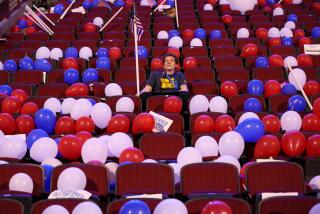Calculating the Sum of All Fears
NEW YORK--Just as Americans had found a way to tame their fears and move forward, the nation’s leaders issued vague warnings of more terrorism.
Most people remain sanguine. But not here. New Yorkers, already wired for caution, find themselves recalculating their daily risks:
Is it safer to ride the subway or bus to work? Do the clothes in the emergency backpack put together in the first month after Sept. 11 still fit the kids? Which public gathering spots are the most likely targets this Memorial Day weekend? Is this for real this time?
Melinda Moss, 48, was asking herself all those questions Wednesday morning as she watched her children file into P.S. 6 on the Upper East Side. Then she hopped a Fifth Avenue bus to midtown instead of taking the usual subway (“I hate being underground at times like this!”), and she promised herself she’d repack that backpack. “I guess I’ve ratcheted up my tolerance level for fear, because I’m not freaking out. But I’m also feeling unsafe again, like I did last fall,” said Moss, an executive secretary. As she passed the Empire State Building, she instinctively lowered her head as if to avoid falling objects. “I get a little crazy around buildings like this,” she said.
The city is again on high alert, with more police patrolling the bridges, tunnels and select landmarks--and with the mayor and police chief sending what has become the standard post-Sept. 11 mixed message: Be cautious, but boldly go on with life.
The New York Post headline writers, ever the hyperbolic town criers, told readers Wednesday on the front page: “The Only Thing We Have to Fear Is Fear Itself.” At the same time, a headline on the ever-balanced New York Times opinion page said: “Cool It!” Certainly, this latest rough-ride over potential terrorism is not confined to New York--even if New Yorkers like to make it their own.
There have been other, nonspecific threats recently to places across the country, such as the water supply in Orlando, Fla., and apartment complexes in Northern California. And people seem in general to be taking the steady stream of warnings in stride.
“I think [the latest warning about inevitable attacks on U.S. soil] is a real threat, but like every other threat we have heard about in the last six months, too vague to really react to,” said Cindy Kline, an executive assistant who works in downtown Seattle. In Los Angeles, law enforcement officials have taken the latest warnings quite seriously, for example, establishing new guidelines for landlords about how to look for suspicious tenants and holding training sessions for emergency workers on preventing suicide bombers. The City Council voted Wednesday to close four additional streets near Los Angeles International Airport for 18 months.
But a few people outside City Hall wondered whether government officials might be too alarmist. Jose G. Valentino, a former Marine, said, “Warnings should be given without scaring people.”
While tourists are not avoiding the standard sites--the Space Needle in Seattle and the John Hancock Building in Chicago, for example, had the usual number of visitors--they do carry some anxiety.
At the Hancock Building, Michele Hudson, 24, of Detroit said she gets nervous when she hears warnings on television. “It’s a holiday weekend. I expected warnings,” she said.
Robert Butterworth, a Los Angeles psychologist specializing in trauma, said Americans now are suffering from what he calls “anticipatory anxiety,” something akin to sitting in a dentist’s office and listening to the drill in the next room.
Terrorism expert Harvey Kushner agreed with government officials who predict suicide attacks on shopping malls and apartments, saying that Americans have to act as their own police.
“The public is going to have to be better educated,” he said. “We have to have a system that traces people.... More than that, we need resolve.”
Stephanie Valada-Viars, a college girl from Iowa, has resolve. But she also has just moved into her first New York apartment--right under the Brooklyn Bridge.
That’s one of the landmarks singled out for attack by an Al Qaeda detainee debriefed by FBI agents. (The bridge is now under 24-hour surveillance by police helicopters and was closed briefly Wednesday because of a suspicious package, which turned out to be a hoax.)
But Valada-Viars, 20, says she will not leave New York. Still, her life these days feels like a road map for terrorist targets: She is working at a Times Square restaurant, she rides the subway, the busy South Street Seaport is two blocks from her apartment and Wall Street is only a few more blocks away.
“It’s definitely uneasy living here,” Valada-Viars said. She’s not expressing that to her mother back in Des Moines. “We’re going to be fine,” she says about herself and her sister Kristina, an aspiring actress also living in New York.
But their mother, T Valada-Viars, who lives in a town where people don’t think about stowing emergency supplies in a backpack, is nobody’s fool. “I tell them: Be happy in your life. It’s the best we all can do. And then I worry. I can’t stop worrying.”
Times staff writers Kenneth Reich and J. Michael Kennedy in Los Angeles and researchers Lynne Marshall in Seattle and John Beckham in Chicago contributed to this report.
More to Read
Sign up for Essential California
The most important California stories and recommendations in your inbox every morning.
You may occasionally receive promotional content from the Los Angeles Times.










